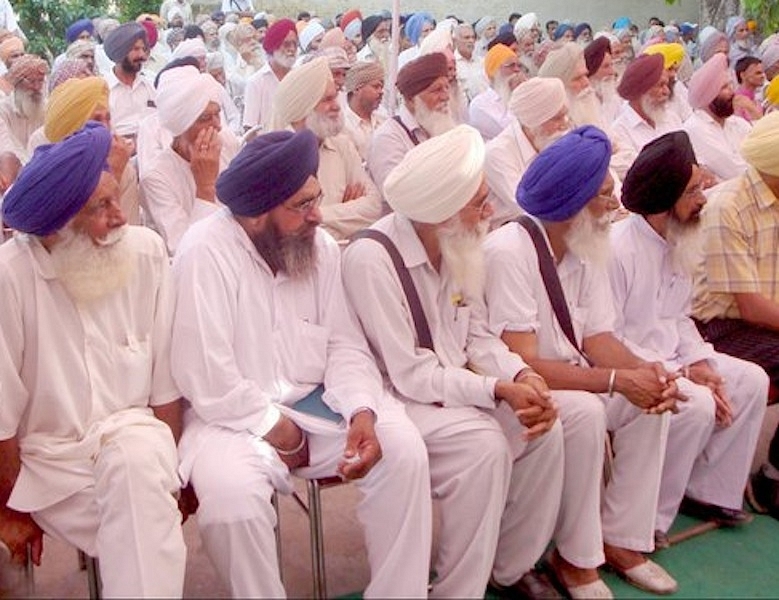
SC Asked: "Are Sikhs A Minority in Punjab?" But This Is The Wrong Question To Ask
Are Sikhs a minority in Punjab, asked an incredulous Supreme Court the other day while hearing a petition from the state government seeking minority rights for Shiromani Gurdwara Prabandhak Committee (SGPC)-run institutions.
A five-judge constitutional bench headed by Chief Justice TS Thakur, along with Justices FMI Kalifulla, AK Sikri, SA Bobde and R Banumathi additionally wondered:
“Can Muslims be treated as a minority in Jammu and Kashmir? For that matter, can Christians, who are the majority in the states of Nagaland and Meghalaya, be also treated as a minority community in these two north-eastern states?”
A question which the court did not ask was this: what if no community is a majority in some states? In a decade or two, the Hindus may no longer constitute more than 50 percent in Kerala.
Good questions, these, but they are the wrong ones. The right question to ask is this: do you have to claim to be a minority group in order to be entitled to the protections under articles 29 and 30 of the constitution, or to reserve seats for members of your community?
Articles 29 and 30 refer to the rights of minorities to run cultural and educational institutions of their own, and their right to non-discrimination by the state.
But the Constitutional Assembly, while admirably trying to protect “minorities” from numerical majorities, forgot a basic thing: it failed to define who or what constitutes a “minority.” And it also presumed that if at all anyone’s rights may be threatened, it would only be the “minorities”.
Due to this definitional gap and unwarranted assumptions, the courts have tried to get into the act, and, as things stand now, minorities are defined as groups that are numerically smaller within state. This is why the Supreme Court asked whether Sikhs are a minority in Punjab, which is manifestly not the case.
The case that has come up before the constitutional bench involves an appeal against a Punjab and Haryana High court decision that rejected a state government order dating back to 2001, under which SGPC-run institutions were declared minority institutions, and thus entitled to reserve 50 percent of seats for Sikhs. The case was brought by a petitioner who contended that due to the 50 percent reservation for Sikhs, his chances of being selected for a seat were reduced, and hence violative of article 14 that guarantees equality of treatment for all citizens.
The problem is that two rights are simultaneously in contention here: one is the right of communities to run their own institutions without state intervention, and the other is the citizen’s right to equality under the law.
Thanks to the mollycoddling of so-called minorities, every community seeks minority status, whether as a religious minority or a linguistic minority. The net result is that the constitutional guarantees under article 14 are applicable only to Hindu institutions, since Muslims, Sikhs, Parsis, and Christians claim minority status no matter where they are located.
An 11-judge bench (in TMA Pai Foundation Vs State of Karnataka), in a 2002 judgment that declared the state as the unit for deciding who is a minority, also prescribed an additional test – whether the group needed protection from the majority, who may gain political power and who may deprive such minority group of their religious, cultural and educational rights. By this yardstick, neither Sikhs nor Christians not Muslims can claim the right to minority status, for there is no majority-threat to their religious or cultural rights.
The fact is that Hindus, despite the community being in a majority in India, are the only ones deprived of their right to run their institutions. Many states in the south have entire ministries to run Hindu religious institutions, and temple boards are stacked with state-appointed nominees. It is not the minority institutions that are being denied the rights to run their own religious institutions.
The only logical way for the Supreme Court to deal with this issue is this: the SGPC should have the right to run its own institutions and for this it need not have to declare itself a minority in the state of Punjab or elsewhere. If all communities are allowed to run religious institutions autonomously, and all educational and health institutions, whether run by minority communities or otherwise, are open to all citizens without quotas for anybody other than SCs/STs, the constitutional provisions would be fully met.
The reason for the separation of religious from educational and health institutions is simple: many educational institutions are often run by minorities (convent schools, etc), and giving preferential admissions to members of the minority community would thus exclude worthy students from other communities from receiving a good education or healthcare.
Alternatively, every community should be eligible to reserve seats for its own members, so that there is equality of treatment of all communities.
Right now, the actual application of constitutional provisions works only against Hindu institutions.